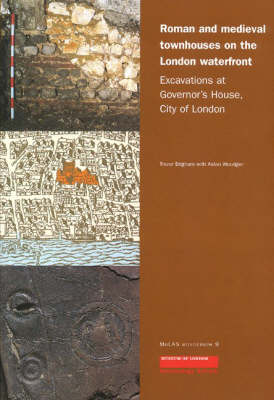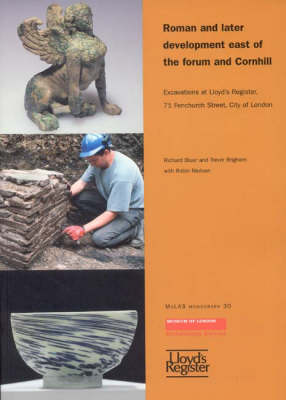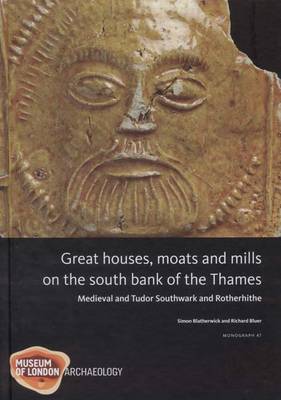MoLAS Monograph
3 primary works
Book 9
Roman and Medieval Townhouses on the London Waterfront
by Trevor Brigham and Aidan Woodger
Published 1 December 2001
The north bank of the Thames near Cannon Street Station was occupied by some of London's most prominent buildings in both the Roman and Medieval periods. Substantial stone walls revealed at the site in 1969 were initially interpreted as part of a Roman townhouse attached to the 'Governor's Palace' building complex to the west. In 1994-7 new excavations uncovered a prehistoric marsh, a riverside quay dated to AD 84 and a revetment constructed in c. AD 100-200. Later Roman buildings were recorded on terraces overlooking the Thames. Two of these buildings predated the townhouse, and one of these may have been a goldworker's premises. Important new evidence for the ground plan and use of the later townhouse has revealed that it developed separately from other large Roman buildings to the west. Part of a Tuscan order column recovered from the site suggests that the building had some architectural pretensions and a high status. In the late 4th century the townhouse was demolished and the settlement abandoned. The first evidence of reoccupation at the site took the form of early 11th century pitting succeeded by sunken-floored or cellared buildings. The walls of the 14th century Pountney's Inn, later the Manor of the Rose, were recorded along Suffolk Lane. This volume presents the results of the archaeological work at this important site in a clear chronological narrative supported by many detailed illustrations and specialist reports.
Book 30
Roman and Later Development East of the Forum and Cornhill
by Richard Bluer, Trevor Brigham, and Robin Nielsen
Published 18 June 2006
Excavations in 1996-7 uncovered important new evidence for the development of the eastern part of the Roman Londinium, as well as medieval and later activity. Early Roman activity took place on sloping ground near a minor tributary of a small stream, known as the Lorteburn in the medieval period. First-century development included ditches and a scatter of timber buildings. Boundaries were aligned with a nearby road to the north-west of the site, and did not match the orientation of either the forum to the west or the Colchester road to the north. Development increased until interrupted by the Hadrianic fire. More substantial stone buildings, reached by secondary alleys or paths, date from the mid 2nd century onwards and include sunken rooms, good-quality painted plaster interior decoration, and unusual ribbon pointing and painted ashlar-effect rustication. A sunken-floored aisled building with brick pier bases may have incorporated a warehouse. In the mid 3rd century new masonry buildings were constructed on a different alignment. The new complex included suites of heated rooms and a possible bathhouse. Contemporary timber structures may have been outbuildings. The site produced an important assemblage of late Roman pottery. The Roman buildings were abandoned in the late 4th-century and their remains sealed by 'dark earth'. Reoccupation was represented by 11th-century rubbish pits and robbing of Roman masonry. The early 12th-century church of St Katherine Coleman lay to the north of open ground and gardens up to the 16th century. Post-Great Fire evidence included fortifications of the rebuilt 18th-century church, vaults of the East India Company Tea and Drug Warehouse and the Hambro synagogue.
Book 47
Great Houses, Moats and Mills on the South Bank of the Thames
by Simon Blatherwick and Richard Bluer
Published 14 April 2009
Regeneration in the 1980s-90s on the south bank of the Thames resulted in archaeological and historical investigations at Platform Wharf, Rotherhithe, and next to London Bridge, in Southwark. The development of both sites from the 14th century is of major interest. The Rotherhithe property was acquired c 1349 by Edward III and the existing house rebuilt by him in 1353-61 with two courts, including a riverside range of apartments. Royal interest ceased after Edward's reign, and the house passed to Bermondsey Priory in 1399. The fragmentation of the site into smaller properties, including ones with industrial uses, is charted. The Southwark site contained three notable residences during the medieval period and tidal mills on the waterfront. The 14th-century moated house of the Dunley family and a pleasure-house built by Edward II, the Rosary, were both acquired by Sir John Fastolf for his own grand London residence in the 1440s. In the later 16th century there was massive immigration into this part of Southwark and by the mid 17th century the former moats and gardens were built over with small properties and alleys. The moat infills produced exceptionally rich assemblages of domestic artefacts and ceramics, the waterside location preserved a wide variety of plants, timber structures and woodworking evidence.


